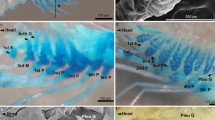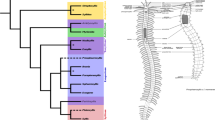Abstract
Pterobranchia and Enteropneusta traditionally form the highest ranking sister taxa within the Hemichordata. The most prominent feature of all representatives of the Hemichordata is the stomochord, which is associated with an anterior excretory complex. The stomochord has been homologized with the notochord of the Chordata species, though this hypothesis is still under debate. Recently, even the validity and position of the Pterobranchia and the Hemichordata has been doubted. These uncertainties are along with a lack of information on the Rhabdopleurida, one of the highest ranking taxa within the Pterobranchia. This study analyzes the stomochord and the heart–glomerulus complex of Rhabdopleura compacta on the ultrastructural level. The data confirm that a glomerulus exists in representatives of the Rhabdopleurida, which previously was only known from the Cephalodiscida, the second highest ranking Pterobranchia taxon. The heart–glomerulus complex is, as expected, associated with the stomochord. Consisting of monociliated, non-vacuolated cells that form a monolayered epithelium of presumed ectodermal origin in R. compacta, the stomochord belongs to the ground pattern of the Pterobranchia and Enteropneusta. Information that would support a homology hypothesis of the chordate notochord and the hemichordate stomochord was not found. Furthermore, there is some evidence that the stomochord might represent a glandular organ. Thus, differences concerning the possible ontogenetic origin, morphology, and function are assumed to result from an independent evolution of the stomochord and the notochord.




Similar content being viewed by others
References
Andersson KA (1907) Die Pterobranchier der schwedischen Südpolarexpedition 1901–1903. Wiss Ergebn Schwed Südpolar-Exp 5:1–122
Ax P (1996) Multicellular animals. A new approach to the phylogenetic order in nature, vol 1. Springer, Berlin Heidelberg New York
Ax P (2003) Multicellular animals. Order in nature—system made by man, vol 3. Springer, Berlin Heidelberg New York
Balser EJ (1985) Ultrastructure and function of the proboscis complex of Saccoglossus (Enteropneusta). Am Zool 25:41A
Balser EJ, Ruppert EE (1990) Structure, ultrastructure, and function of the preoral heart–kidney in Saccoglossus kowalevskii (Hemichordata, Enteropneusta) including new data on the stomochord. Acta Zool 71:235–249
Bargmann W, Hehn G von (1968) Über das Axial-Organ ("mysterious gland") von Asterias rubens. Z Zellforsch 88:262–277
Bateson W (1884) Note on the later stages in the development of Balanoglossus kowalevskii (Agassiz), and on the affinities of the Enteropneusta. Proc R Soc Lond 38:23–30
Bateson W (1886) The ancestry of the Chordata. Q J Microsc Sci 26:535–571
Benito J, Pardos F (1997) Hemichordata. In: Harrison FW, Ruppert EE (eds) Microscopic anatomy of invertebrates, vol 15. Wiley-Liss, New York, pp 15–101
Burghel P, Cloney RA (1997) Urochordata: Ascidiacea. In: Harrison FW, Ruppert EE (eds) Microscopic anatomy of invertebrates, vol 15. Wiley-Liss, New York, pp 221–347
Cameron CB, Garey JR, Swalla BJ (2000) Evolution of the chordate body plan: new insights from phylogenetic analyses of deuterostome phyla. Proc Natl Acad Sci U S A 97:4469–4474
Cloney RA (1964) Development of the ascidian notochord. Acta Embryol Morphol Exp 7:111–130
Dawydoff C (1948) Conception morphologique du stomochordé. In: Grassé PP (ed) Traité de Zoologie, vol 11. Masson, Paris, pp 510–532
Dilly PN, Welsch U, Rehkämper G (1986a) Fine structure of heart, pericardium and glomerular vessel in Cephalodiscus gracilis M'Intosh, 1882 (Pterobranchia, Hemichordata). Acta Zool 67:173–179
Dilly PN, Welsch U, Rehkämper G (1986b) On the fine structure of the alimentary tract of Cephalodiscus gracilis (Pterobranchia, Hemichordata). Acta Zool 67:87–95
Halanych KM (1995) The phylogenetic position of the Pterobranch hemichordates based on 18S rDNA sequence data. Mol Phyl Evol 4:72–76
Halanych KM (1996) Convergence in the feeding apparatuses of lophophorates and pterobranch hemichordates revealed by 18S rDNA: an interpretation. Biol Bull 190:1–5
Harmer SF (1905) The Pterobranchia of the Siboga expedition with an account on other species. In: Weber M (ed) Résultats des explorations à bord du Siboga, monographie, vol 26. Brill, Leyden, pp 1–132
Hyman LH (1959) Phylum Hemichordata. In: Boell EJ (ed) The invertebrates, vol 5. McGraw-Hill, New York, pp 72–207
Komai T (1949) Internal structure of the pterobranch Atubaria heterolopha Sato, with an appendix on the homology of the notochord. Proc Jpn Acad 25:19–24
Lester SM (1988) Settlement and metamorphosis of Rhabdopleura normani (Hemichordata: Pterobranchia). Acta Zool 69:111–120
Masterman AT (1897) On the notochord of Cephalodiscus. Zool Anz 20:443–450
Nielsen C (2001) Animal evolution. Interrelationships of the living phyla. Oxford University Press, Oxford
Olsson R (1965) Comparative morphology and physiology of the Oikopleura notochord. Isr J Zool 14:213–220
Peterson KJ, Cameron RA, Tagawa K, Satoh N, Davidson EH (1999) A comparative molecular approach to mesodermal patterning in basal deuterostomes: the expression pattern of Brachyury in the enteropneust hemichordate Ptychodera flava. Development 126:85–95
Ridewood WG (1918) Cephalodiscus. British Antarctic ("terra nova") expedition, 1910. Natural history report. Zoology 4:11–82
Ruppert EE (1997a) Introduction: microscopic anatomy of the notochord, heterochrony, and chordate evolution. In: Harrison FW, Ruppert EE (eds) Microscopic anatomy of invertebrates, vol 15. Wiley-Liss, New York, pp 1–13
Ruppert EE (1997b) Cephalochordata (Acrania). In: Harrison FW, Ruppert EE (eds) Microscopic anatomy of invertebrates, vol 15. Wiley-Liss, New York, pp 349–504
Ruppert EE, Balser JB (1986) Nephridia in the larvae of hemichordates and echinoderms. Biol Bull 171:188–196
Ruppert EE, Smith PR (1988) The functional organisation of filtration nephridia. Biol Rev 63:231–258
Schepotieff A (1907a) Die Pterobranchier. Anatomische und histologische Untersuchungen über Rhabdopleura normani Allman und Cephalodiscus dodecalophus M'Int. 1. Teil. Rhabdopleura normani. 1. Abschnitt. Die Anatomie von Rhabdopleura. Zool Jahrb 23:463–534
Schepotieff A (1907b) Die Pterobranchier. Anatomische und histologische Untersuchungen über Rhabdopleura normani Allman und Cephalodiscus dodecalophus M'Int. 1. Teil. Rhabdopleura normani. 2. Abschnitt. Knospungsprozess und Gehäuse von Rhabdopleura. Zool Jahrb 24:193–238
Spengel JW (1893) Die Enteropneusten des Golfes von Neapel und der angrenzenden Meeresabschnitte. Fauna und Flora des Golfes von Neapel. 18. Monographie. Friedländer, Berlin
Tagawa K, Humphreys T, Satoh N (1998) Gene expression pattern. Novel pattern of Brachyury gene expression in hemichordate embryos. Mech Dev 75:139–143
Takacs CM, Moy VN, Peterson KJ (2002) Testing putative hemichordate homologues of the chordate dorsal nervous system and endostyle: expression of NK2.1 (TTF-1) in the acorn worm Ptychodera flava (Hemichordata, Ptychoderidae). Evol Dev 4:405–417
Welsch U, Storch V (1969) Zur Feinstruktur der Chorda dorsalis niederer Chordaten (Dendrodoa grossularia (v. Beneden) und Oikopleura dioica Fol). Z Zellforsch 93:547–559
Welsch U, Storch V (1970) Fine structure of the stomochord of the enteropneusts Harrimania kupfferi and Ptychodera flava. Z Zellforsch 107:234–239
Welsch U, Dilly PN, Rehkämper G (1987) The fine structure of the stomochord in Cephalodiscus gracilis M'Intosh, 1882 (Hemichordata, Pterobranchia). Zool Anz 218:209–218
Wilke U (1972a) Der Eicheldarm der Enteropneusten als Stützorgan für Glomerulus und Perikardialvesikel. Verh Dtsch Zool Ges 66:93–96
Wilke U (1972b) Die Feinstruktur des Glomerulus von Glossobalanus minutus Kowalewsky (Enteropneusta). Cytobiologie 5:439–447
Acknowledgements
We thank Dr. C. Lüter and Prof. Dr. O. Kraus for criticizing the manuscript. We are also grateful to P. Grobe for collecting the material. This work was supported by the Studienstiftung des deutschen Volkes.
Author information
Authors and Affiliations
Corresponding author
Rights and permissions
About this article
Cite this article
Mayer, G., Bartolomaeus, T. Ultrastructure of the stomochord and the heart–glomerulus complex in Rhabdopleura compacta (Pterobranchia): phylogenetic implications. Zoomorphology 122, 125–133 (2003). https://doi.org/10.1007/s00435-003-0078-z
Received:
Accepted:
Published:
Issue Date:
DOI: https://doi.org/10.1007/s00435-003-0078-z




